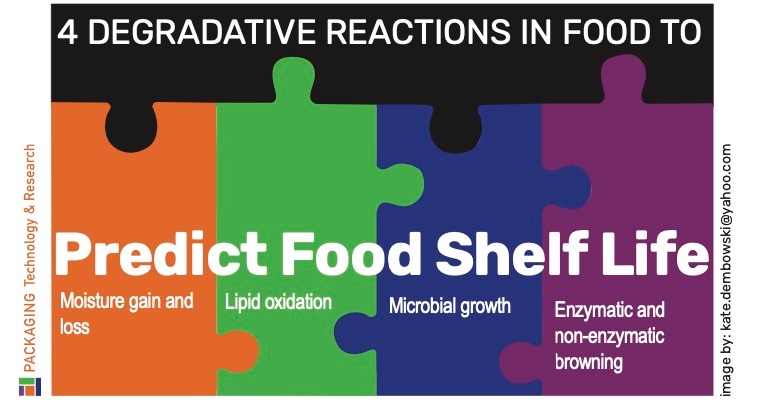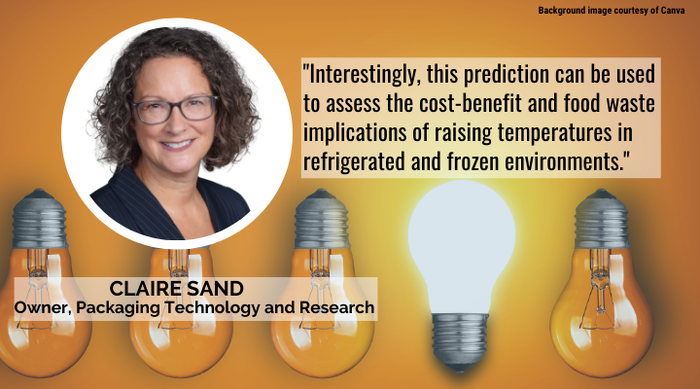4 Vital Shelf-Life Prediction Methods for Food Packaging
Knowing more about analyses for water vapor, oxidation, microbial growth, and enzymatic activity can save you time, money, and headaches.
January 27, 2022

Need to switch out packaging due to sourcing, sustainability, cost drivers, or to meet launch timing? Predicting shelf life coupled with experiential knowledge — benchmarking what competitors and current product barriers are, packaging supplier insights, distribution temperature, humidity realities, and considering additional shelf life or product differences — saves time and money.
To predict shelf life, the impact of packaging science-based solutions — active and intelligent packaging and permeability — is measured against the kinetics of these four main food reactions:
1. Water vapor loss and gain, including during freeze-thaws: water gain and loss results in the end of shelf life for low moisture foods (crackers) and high moisture foods (grapes). The relationship between moisture and water activity (aw and partial pressure of water vapor above food, relative humidity/100) in a moisture sorption isotherm essentially translates food moisture loss and gain to package water vapor permeability and allows the required package barrier to be determined. Predicting the complexities of freeze-thaw cycles - interfacial water is lost, cell walls within food rupture resulting in freezer burn and mushy textures (frozen green beans) — allows for the benefits of high barriers vs. low barriers to be rapidly assessed. Packaging science is center stage. Glass transition temperature (Tg) that governs the temperature and permeation relationship need to be understood when translating the package water vapor typically reported by suppliers at a high temperature to the use temperatures.
2. Oxidation of unsaturated fats: the amount of double and triple bonds and antioxidants in food and packaging are used to establish the propensity to oxidize used to predict the required oxygen barrier. For example, better oxygen and light barriers are required when health bars contain more unsaturated fats than saturated fats. When food oxidizes, volatile off-flavors and odors are produced. This creates 2 options:
A. Porous packaging to allow oxidation to occur and release foul odors/flavors or
B. High barrier with a low O2 environment to inhibit oxidation. The material and capital cost difference between these two options can make or break a product’s commercial viability. Flavor and nutrient loss are often linked to either moisture or oxygen presence, and predicting the required barrier involves understanding the reaction on a mole-to-mole basis.

3. Microbial growth of yeast/mold and pathogens: controlling the growth of pathogens such as Listeria, E.Coli, Samonella, Campylobacter) is a major food safety concern. To predict shelf life, microbial growth kinetics and the impact of environmental (temperature, relative humidity, Oxygen) factors are determined. Then the package environment to stall growth is then defined, and shelf life is predicted.
Because pathogens such as Listeria are not detectable below 3cfu/ml, predictive microbiology has been applied to define its presence. Accurate shelf-life prediction incorporates different microbial growth kinetics under variable time-temperature conditions. This involved prediction is imperative since the temperature varies during distribution, retail, and consumer refrigerators.
Predicting the impact of active package solutions aids in building the business case for solutions such as packaging that emits sulfur dioxide to reduce fungus in packaged blueberries. Likewise, intelligent packaging is calibrated to mimic microbial growth or measures by-products such as hydrogen sulfide and carbon dioxide to establish the shelf life of individual packaging and secondary packaging or entire pallet loads.
4. Enzymatic and non-enzymatic activity: enzymes cause flavor change (lipoxygenase) in unprocessed fruits and vegetables and as frozen meat and poultry are exposed to warm temperatures.
The impact of active packaging solutions such as controlled release citric acid is predicted on a mole-to-mole basis between the reacting compounds. For non-enzymatic browning (Maillard reaction), the reaction between proteins and reducing sugars is applied to predict food shelf life.
Shelf-life prediction also allows for accelerated shelf-life testing that shortens the time needed for shelf-life results. Essentially a correlation between shelf life at the “usual” and accelerated conditions are established. Importantly, this is based on deteriorative reactions not changing between accelerated and normal shelf-life conditions. Interestingly, this prediction can be used to assess the cost-benefit and food waste implications of raising temperatures in refrigerated and frozen environments.
Greg Nelson, Director New Business Development at Progressive Packaging, summarizes it perfectly: “With the intensely rapid and broad-based changes in environmental impact, production automation, lengthy distribution chains, and consumer demands, innovation and shelf life prediction is critical to the major food suppliers who need to operate in the food supply chain quickly and cost-effectively to provide safe and quality products for a diverse and changing consumer base.”
Claire Sand has 30+ years of experience in industry and academia. She’s owner of Packaging Technology and Research and Gazelle Mobile Packaging and an Adjunct Professor, CalPoly, Michigan State University, and the University of Minnesota. You can reach her at www.packagingtechnologyandresearch.com or via email [email protected].
About the Author(s)
You May Also Like




